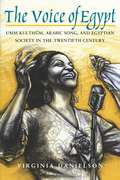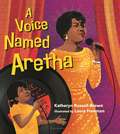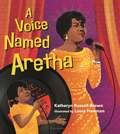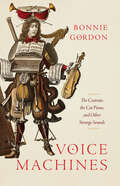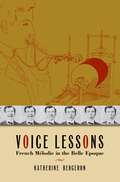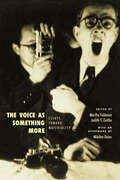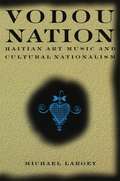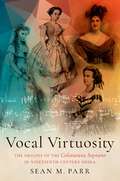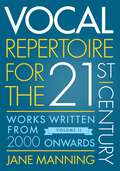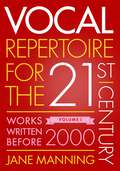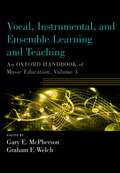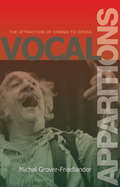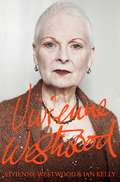- Table View
- List View
"The Voice of Egypt": Umm Kulthum, Arabic Song, and Egyptian Society in the Twentieth Century (Chicago Studies in Ethnomusicology #1997)
by Virginia DanielsonUmm Kulthum, the "voice of Egypt," was the most celebrated musical performer of the century in the Arab world. More than twenty years after her death, her devoted audience, drawn from all strata of Arab society, still numbers in the millions. Thanks to her skillful and pioneering use of mass media, her songs still permeate the international airwaves. In the first English-language biography of Umm Kulthum, Virginia Danielson chronicles the life of a major musical figure and the confluence of artistry, society, and creativity that characterized her remarkable career. Danielson examines the careful construction of Umm Kulthum's phenomenal popularity and success in a society that discouraged women from public performance. From childhood, her mentors honed her exceptional abilities to accord with Arab and Muslim practice, and as her stature grew, she remained attentive to her audience and the public reception of her work. Ultimately, she created from local precendents and traditions her own unique idiom and developed original song styles from both populist and neo-classical inspirations. These were enthusiastically received, heralded as crowning examples of a new, yet authentically Arab-Egyptian, culture. Danielson shows how Umm Kulthum's music and public personality helped form popular culture and contributed to the broader artistic, societal, and political forces that surrounded her. This richly descriptive account joins biography with social theory to explore the impact of the individual virtuoso on both music and society at large while telling the compelling story of one of the most famous musicians of all time. "She is born again every morning in the heart of 120 million beings. In the East a day without Umm Kulthum would have no color."—Omar Sharif
"The Voice of Egypt": Umm Kulthum, Arabic Song, and Egyptian Society in the Twentieth Century (Chicago Studies in Ethnomusicology #1997)
by Virginia DanielsonUmm Kulthum, the "voice of Egypt," was the most celebrated musical performer of the century in the Arab world. More than twenty years after her death, her devoted audience, drawn from all strata of Arab society, still numbers in the millions. Thanks to her skillful and pioneering use of mass media, her songs still permeate the international airwaves. In the first English-language biography of Umm Kulthum, Virginia Danielson chronicles the life of a major musical figure and the confluence of artistry, society, and creativity that characterized her remarkable career. Danielson examines the careful construction of Umm Kulthum's phenomenal popularity and success in a society that discouraged women from public performance. From childhood, her mentors honed her exceptional abilities to accord with Arab and Muslim practice, and as her stature grew, she remained attentive to her audience and the public reception of her work. Ultimately, she created from local precendents and traditions her own unique idiom and developed original song styles from both populist and neo-classical inspirations. These were enthusiastically received, heralded as crowning examples of a new, yet authentically Arab-Egyptian, culture. Danielson shows how Umm Kulthum's music and public personality helped form popular culture and contributed to the broader artistic, societal, and political forces that surrounded her. This richly descriptive account joins biography with social theory to explore the impact of the individual virtuoso on both music and society at large while telling the compelling story of one of the most famous musicians of all time. "She is born again every morning in the heart of 120 million beings. In the East a day without Umm Kulthum would have no color."—Omar Sharif
"The Voice of Egypt": Umm Kulthum, Arabic Song, and Egyptian Society in the Twentieth Century (Chicago Studies in Ethnomusicology #1997)
by Virginia DanielsonUmm Kulthum, the "voice of Egypt," was the most celebrated musical performer of the century in the Arab world. More than twenty years after her death, her devoted audience, drawn from all strata of Arab society, still numbers in the millions. Thanks to her skillful and pioneering use of mass media, her songs still permeate the international airwaves. In the first English-language biography of Umm Kulthum, Virginia Danielson chronicles the life of a major musical figure and the confluence of artistry, society, and creativity that characterized her remarkable career. Danielson examines the careful construction of Umm Kulthum's phenomenal popularity and success in a society that discouraged women from public performance. From childhood, her mentors honed her exceptional abilities to accord with Arab and Muslim practice, and as her stature grew, she remained attentive to her audience and the public reception of her work. Ultimately, she created from local precendents and traditions her own unique idiom and developed original song styles from both populist and neo-classical inspirations. These were enthusiastically received, heralded as crowning examples of a new, yet authentically Arab-Egyptian, culture. Danielson shows how Umm Kulthum's music and public personality helped form popular culture and contributed to the broader artistic, societal, and political forces that surrounded her. This richly descriptive account joins biography with social theory to explore the impact of the individual virtuoso on both music and society at large while telling the compelling story of one of the most famous musicians of all time. "She is born again every morning in the heart of 120 million beings. In the East a day without Umm Kulthum would have no color."—Omar Sharif
"The Voice of Egypt": Umm Kulthum, Arabic Song, and Egyptian Society in the Twentieth Century (Chicago Studies in Ethnomusicology #1997)
by Virginia DanielsonUmm Kulthum, the "voice of Egypt," was the most celebrated musical performer of the century in the Arab world. More than twenty years after her death, her devoted audience, drawn from all strata of Arab society, still numbers in the millions. Thanks to her skillful and pioneering use of mass media, her songs still permeate the international airwaves. In the first English-language biography of Umm Kulthum, Virginia Danielson chronicles the life of a major musical figure and the confluence of artistry, society, and creativity that characterized her remarkable career. Danielson examines the careful construction of Umm Kulthum's phenomenal popularity and success in a society that discouraged women from public performance. From childhood, her mentors honed her exceptional abilities to accord with Arab and Muslim practice, and as her stature grew, she remained attentive to her audience and the public reception of her work. Ultimately, she created from local precendents and traditions her own unique idiom and developed original song styles from both populist and neo-classical inspirations. These were enthusiastically received, heralded as crowning examples of a new, yet authentically Arab-Egyptian, culture. Danielson shows how Umm Kulthum's music and public personality helped form popular culture and contributed to the broader artistic, societal, and political forces that surrounded her. This richly descriptive account joins biography with social theory to explore the impact of the individual virtuoso on both music and society at large while telling the compelling story of one of the most famous musicians of all time. "She is born again every morning in the heart of 120 million beings. In the East a day without Umm Kulthum would have no color."—Omar Sharif
A Voice Named Aretha
by Katheryn Russell-BrownFrom acclaimed author and illustrator pairing comes a beautiful picture book biography about the Queen of Soul Aretha Franklin and how she fought for respect throughout her life.Aretha Franklin is the Queen of Soul, a legend. But before she became a star, she was a shy little girl with a voice so powerful it made people jump up, sway, and hum along. Raised in a house full of talking and singing, Aretha learned the values that would carry her through life--from her church choir in Detroit to stages across the world. When she moved to New York City to start her career, it took years of hard work before she had a hit song. In the turbulent 1960s, she sang about "Respect" and refused to perform before segregated audiences. The first woman inducted into the Rock & Roll Hall of Fame, Aretha always remembered who she was and where she came from. In this stirring biography of a true artistic and social icon, award-winning creators Katheryn Russell-Brown and Laura Freeman show young readers how Aretha's talent, intelligence, and perseverance made her a star who will shine on for generations to come.Acclaim for Little Melba and Her Big Trombone2015 NAACP Image Award Nominee Outstanding Literary Work--Children 2015 Coretta Scott King Illustrator Award Honor2015 ALA Notable Children's Book2015 Amelia Bloomer Project - Feminist Task Force2015 Orbis Pictus Award for Outstanding Nonfiction, Recommended Title
A Voice Named Aretha
by Katheryn Russell-BrownFrom acclaimed author and illustrator pairing comes a beautiful picture book biography about the Queen of Soul Aretha Franklin and how she fought for respect throughout her life.Aretha Franklin is the Queen of Soul, a legend. But before she became a star, she was a shy little girl with a voice so powerful it made people jump up, sway, and hum along. Raised in a house full of talking and singing, Aretha learned the values that would carry her through life--from her church choir in Detroit to stages across the world. When she moved to New York City to start her career, it took years of hard work before she had a hit song. In the turbulent 1960s, she sang about "Respect" and refused to perform before segregated audiences. The first woman inducted into the Rock & Roll Hall of Fame, Aretha always remembered who she was and where she came from. In this stirring biography of a true artistic and social icon, award-winning creators Katheryn Russell-Brown and Laura Freeman show young readers how Aretha's talent, intelligence, and perseverance made her a star who will shine on for generations to come.Acclaim for Little Melba and Her Big Trombone2015 NAACP Image Award Nominee Outstanding Literary Work--Children 2015 Coretta Scott King Illustrator Award Honor2015 ALA Notable Children's Book2015 Amelia Bloomer Project - Feminist Task Force2015 Orbis Pictus Award for Outstanding Nonfiction, Recommended Title
Voice Machines: The Castrato, the Cat Piano, and Other Strange Sounds
by Bonnie GordonAn exploration of the castrato as a critical provocation to explore the relationships between sound, music, voice instrument, and machine. Italian courts and churches began employing castrato singers in the late sixteenth century. By the eighteenth century, the singers occupied a celebrity status on the operatic stage. Constructed through surgical alteration and further modified by rigorous training, castrati inhabited human bodies that had been “mechanized” to produce sounds in ways that unmechanized bodies could not. The voices of these technologically enhanced singers, with their unique timbre, range, and strength, contributed to a dramatic expansion of musical vocabulary and prompted new ways of imagining sound, the body, and personhood. Connecting sometimes bizarre snippets of history, this multi-disciplinary book moves backward and forward in time, deliberately troubling the meaning of concepts like “technology” and “human.” Voice Machines attends to the ways that early modern encounters and inventions—including settler colonialism, emergent racialized worldviews, the printing press, gunpowder, and the telescope—participated in making castrati. In Bonnie Gordon’s revealing study, castrati serve as a critical provocation to ask questions about the voice, the limits of the body, and the stories historians tell.
Voice Lessons: French Mélodie in the Belle Epoque (New Cultural History of Music)
by Katherine BergeronLanguage, education, politics, and music come together in Katherine Bergeron's Voice Lessons, a study of the French mélodie in the Belle Epoque. Close readings of songs by Fauré, Debussy, and Ravel, along with poems, sound recordings, and other historical documents, seek to uncovers the cultural meanings of this art: why it emerged, why it mattered, and why it eventually disappeared.
The Voice as Something More: Essays toward Materiality (New Material Histories of Music)
by Mladen DolarIn the contemporary world, voices are caught up in fundamentally different realms of discourse, practice, and culture: between sounding and nonsounding, material and nonmaterial, literal and metaphorical. In The Voice as Something More, Martha Feldman and Judith T. Zeitlin tackle these paradoxes with a bold and rigorous collection of essays that look at voice as both object of desire and material object. Using Mladen Dolar’s influential A Voice and Nothing More as a reference point, The Voice as Something More reorients Dolar’s psychoanalytic analysis around the material dimensions of voices—their physicality and timbre, the fleshiness of their mechanisms, the veils that hide them, and the devices that enhance and distort them. Throughout, the essays put the body back in voice. Ending with a new essay by Dolar that offers reflections on these vocal aesthetics and paradoxes, this authoritative, multidisciplinary collection, ranging from Europe and the Americas to East Asia, from classics and music to film and literature, will serve as an essential entry point for scholars and students who are thinking toward materiality.
The Voice as Something More: Essays toward Materiality (New Material Histories of Music)
by Mladen DolarIn the contemporary world, voices are caught up in fundamentally different realms of discourse, practice, and culture: between sounding and nonsounding, material and nonmaterial, literal and metaphorical. In The Voice as Something More, Martha Feldman and Judith T. Zeitlin tackle these paradoxes with a bold and rigorous collection of essays that look at voice as both object of desire and material object. Using Mladen Dolar’s influential A Voice and Nothing More as a reference point, The Voice as Something More reorients Dolar’s psychoanalytic analysis around the material dimensions of voices—their physicality and timbre, the fleshiness of their mechanisms, the veils that hide them, and the devices that enhance and distort them. Throughout, the essays put the body back in voice. Ending with a new essay by Dolar that offers reflections on these vocal aesthetics and paradoxes, this authoritative, multidisciplinary collection, ranging from Europe and the Americas to East Asia, from classics and music to film and literature, will serve as an essential entry point for scholars and students who are thinking toward materiality.
The Voice as Something More: Essays toward Materiality (New Material Histories of Music)
by Mladen DolarIn the contemporary world, voices are caught up in fundamentally different realms of discourse, practice, and culture: between sounding and nonsounding, material and nonmaterial, literal and metaphorical. In The Voice as Something More, Martha Feldman and Judith T. Zeitlin tackle these paradoxes with a bold and rigorous collection of essays that look at voice as both object of desire and material object. Using Mladen Dolar’s influential A Voice and Nothing More as a reference point, The Voice as Something More reorients Dolar’s psychoanalytic analysis around the material dimensions of voices—their physicality and timbre, the fleshiness of their mechanisms, the veils that hide them, and the devices that enhance and distort them. Throughout, the essays put the body back in voice. Ending with a new essay by Dolar that offers reflections on these vocal aesthetics and paradoxes, this authoritative, multidisciplinary collection, ranging from Europe and the Americas to East Asia, from classics and music to film and literature, will serve as an essential entry point for scholars and students who are thinking toward materiality.
The Voice as Something More: Essays toward Materiality (New Material Histories of Music)
by Mladen DolarIn the contemporary world, voices are caught up in fundamentally different realms of discourse, practice, and culture: between sounding and nonsounding, material and nonmaterial, literal and metaphorical. In The Voice as Something More, Martha Feldman and Judith T. Zeitlin tackle these paradoxes with a bold and rigorous collection of essays that look at voice as both object of desire and material object. Using Mladen Dolar’s influential A Voice and Nothing More as a reference point, The Voice as Something More reorients Dolar’s psychoanalytic analysis around the material dimensions of voices—their physicality and timbre, the fleshiness of their mechanisms, the veils that hide them, and the devices that enhance and distort them. Throughout, the essays put the body back in voice. Ending with a new essay by Dolar that offers reflections on these vocal aesthetics and paradoxes, this authoritative, multidisciplinary collection, ranging from Europe and the Americas to East Asia, from classics and music to film and literature, will serve as an essential entry point for scholars and students who are thinking toward materiality.
The Voice as Something More: Essays toward Materiality (New Material Histories of Music)
by Mladen DolarIn the contemporary world, voices are caught up in fundamentally different realms of discourse, practice, and culture: between sounding and nonsounding, material and nonmaterial, literal and metaphorical. In The Voice as Something More, Martha Feldman and Judith T. Zeitlin tackle these paradoxes with a bold and rigorous collection of essays that look at voice as both object of desire and material object. Using Mladen Dolar’s influential A Voice and Nothing More as a reference point, The Voice as Something More reorients Dolar’s psychoanalytic analysis around the material dimensions of voices—their physicality and timbre, the fleshiness of their mechanisms, the veils that hide them, and the devices that enhance and distort them. Throughout, the essays put the body back in voice. Ending with a new essay by Dolar that offers reflections on these vocal aesthetics and paradoxes, this authoritative, multidisciplinary collection, ranging from Europe and the Americas to East Asia, from classics and music to film and literature, will serve as an essential entry point for scholars and students who are thinking toward materiality.
The Voice as Something More: Essays toward Materiality (New Material Histories of Music)
by Mladen DolarIn the contemporary world, voices are caught up in fundamentally different realms of discourse, practice, and culture: between sounding and nonsounding, material and nonmaterial, literal and metaphorical. In The Voice as Something More, Martha Feldman and Judith T. Zeitlin tackle these paradoxes with a bold and rigorous collection of essays that look at voice as both object of desire and material object. Using Mladen Dolar’s influential A Voice and Nothing More as a reference point, The Voice as Something More reorients Dolar’s psychoanalytic analysis around the material dimensions of voices—their physicality and timbre, the fleshiness of their mechanisms, the veils that hide them, and the devices that enhance and distort them. Throughout, the essays put the body back in voice. Ending with a new essay by Dolar that offers reflections on these vocal aesthetics and paradoxes, this authoritative, multidisciplinary collection, ranging from Europe and the Americas to East Asia, from classics and music to film and literature, will serve as an essential entry point for scholars and students who are thinking toward materiality.
Vodou Nation: Haitian Art Music and Cultural Nationalism (Chicago Studies in Ethnomusicology)
by Michael LargeyWhile the Haitian musical tradition is probably best known for the Vodou-inspired roots music that helped topple the two-generation Duvalier dictatorship, the nation’s troubled history of civil unrest and its tangled relationship with the United States is more intensely experienced through its art music, which combines French and German elements of classical music with Haiti's indigenous folk music. Vodou Nation examines art music by Haitian and African American composers who were inspired by Haiti’s history as a nation created by slave revolt. Around the time of the United States’s occupation of Haiti in 1915, African American composers began to incorporate Vodou-inspired musical idioms to showcase black artistry and protest white oppression. Together with Haitian musicians, these composers helped create what Michael Largey calls the “Vodou Nation,” an ideal vision of Haiti that championed its African-based culture as a bulwark against America’s imperialism. Highlighting the contributions of many Haitian and African American composers who wrote music that brought rhythms and melodies of the Vodou ceremony to local and international audiences, Vodou Nation sheds light on a black cosmopolitan musical tradition that was deeply rooted in Haitian culture and politics.
Vocal Virtuosity: The Origins of the Coloratura Soprano in Nineteenth-Century Opera
by Sean M. ParrNothing strikes the ear quite like a soprano singing in the sonic stratosphere. Whether thrilling, chilling, or repellent to the listener, the reaction to cascades of coloratura with climaxing high notes is strong. Coloratura-agile, rapid-fire singing-was originally essential for all singers, but its function changed greatly when it became the specialty of particular sopranos over the course of the nineteenth century. The central argument of Vocal Virtuosity challenges the historical commonplace that coloratura became an anachronism in nineteenth-century opera. Instead, the book demonstrates that melismas at mid-century were made modern. Coloratura became an increasingly marked musical gesture during the century with a correspondingly more specific dramaturgical function. In exploring this transformation, the book reveals the instigators of this change in vocal practice and examines the historical traces of Parisian singers who were the period's greatest exponents of vertiginous vocality as archetypes of the modern coloratura soprano. The book constructs the historical trajectory of coloratura as it became gendered the provenance of the female singer, while also considering what melismas can signify in operatic performance. As a whole, it argues that vocal virtuosity was a source of power for women, generating space for female authorship and creativity. In so doing, the book reclaims a place in history for the coloratura soprano.
Vocal Virtuosity: The Origins of the Coloratura Soprano in Nineteenth-Century Opera
by Sean M. ParrNothing strikes the ear quite like a soprano singing in the sonic stratosphere. Whether thrilling, chilling, or repellent to the listener, the reaction to cascades of coloratura with climaxing high notes is strong. Coloratura-agile, rapid-fire singing-was originally essential for all singers, but its function changed greatly when it became the specialty of particular sopranos over the course of the nineteenth century. The central argument of Vocal Virtuosity challenges the historical commonplace that coloratura became an anachronism in nineteenth-century opera. Instead, the book demonstrates that melismas at mid-century were made modern. Coloratura became an increasingly marked musical gesture during the century with a correspondingly more specific dramaturgical function. In exploring this transformation, the book reveals the instigators of this change in vocal practice and examines the historical traces of Parisian singers who were the period's greatest exponents of vertiginous vocality as archetypes of the modern coloratura soprano. The book constructs the historical trajectory of coloratura as it became gendered the provenance of the female singer, while also considering what melismas can signify in operatic performance. As a whole, it argues that vocal virtuosity was a source of power for women, generating space for female authorship and creativity. In so doing, the book reclaims a place in history for the coloratura soprano.
Vocal Repertoire for the Twenty-First Century, Volume 2: Works Written From 2000 Onwards
by Jane ManningDescribed as the "life and soul of British contemporary music", Jane Manning is an internationally celebrated English concert and opera soprano. In this new follow-up to her highly regarded New Vocal Repertory, Volumes I and II, she provides a seasoned expert's guidance and insight into the vocal genre she calls home. Vocal Repertoire for the Twenty-First Century spans the late middle-20th century through the second decade of the 21st. Manning's comprehensive selection of contemporary art songs ranges from the avant-garde to the more easily accessible, including substantial song cycles, shorter encore pieces, and songs suitable for auditions and competitions. The two-volume guide presents expertly-informed selections tailored to particular voice types. Each of the 160 selections is accompanied by a highly detailed performance guide, music examples, levels of difficulty, and a brief encapsulation of vocal characteristics or challenges contained in the piece. A supplemental companion website provides composer biographies and an up-to-date list of recommended recordings. With a focus on younger composers in addition to prominent figures, Manning encourages singers to refresh and expand their recital repertoire into less familiar territory, and discover the rewards therein. Volume 2 features works written from 2000 onwards, including pieces from contemporary composers Mohammed Fairouz ("Annabel Lee"), Missy Mazzoli ("As Long as We Live"), Judith Weir ("The Voice of Desire"), and Raymond Yiu ("The Earth and Every Common Sight").
Vocal Repertoire for the Twenty-First Century, Volume 1: Works Written Before 2000
by Jane ManningDescribed as the "life and soul of British contemporary music", Jane Manning is an internationally celebrated English concert and opera soprano. In this new follow-up to her highly regarded New Vocal Repertory, Volumes I and II, she provides a seasoned expert's guidance and insight into the vocal genre she calls home. Vocal Repertoire for the Twenty-First Century spans the late middle-20th century through the second decade of the 21st. Manning's comprehensive selection of contemporary art songs ranges from the avant-garde to the more easily accessible, including substantial song cycles, shorter encore pieces, and songs suitable for auditions and competitions. The two-volume guide presents expertly-informed selections tailored to particular voice types. Each of the 160 selections is accompanied by a highly detailed performance guide, music examples, levels of difficulty, and a brief encapsulation of vocal characteristics or challenges contained in the piece. A supplemental companion website provides composer biographies and an up-to-date list of recommended recordings. With a focus on younger composers in addition to prominent figures, Manning encourages singers to refresh and expand their recital repertoire into less familiar territory, and discover the rewards therein. Volume 1 features works written before 2000, including pieces from such renowned composers as John Cage ("The Wonderful Widow of Eighteen Springs", "A Flower"), André Previn ("Five Songs"), and Igor Stravinsky ("The Owl and the Pussycat").
VOCAL REPERTOIRE FOR 21ST C. V1 C: Works Written Before 2000
by Jane ManningDescribed as the "life and soul of British contemporary music", Jane Manning is an internationally celebrated English concert and opera soprano. In this new follow-up to her highly regarded New Vocal Repertory, Volumes I and II, she provides a seasoned expert's guidance and insight into the vocal genre she calls home. Vocal Repertoire for the Twenty-First Century spans the late middle-20th century through the second decade of the 21st. Manning's comprehensive selection of contemporary art songs ranges from the avant-garde to the more easily accessible, including substantial song cycles, shorter encore pieces, and songs suitable for auditions and competitions. The two-volume guide presents expertly-informed selections tailored to particular voice types. Each of the 160 selections is accompanied by a highly detailed performance guide, music examples, levels of difficulty, and a brief encapsulation of vocal characteristics or challenges contained in the piece. A supplemental companion website provides composer biographies and an up-to-date list of recommended recordings. With a focus on younger composers in addition to prominent figures, Manning encourages singers to refresh and expand their recital repertoire into less familiar territory, and discover the rewards therein. Volume 1 features works written before 2000, including pieces from such renowned composers as John Cage ("The Wonderful Widow of Eighteen Springs", "A Flower"), André Previn ("Five Songs"), and Igor Stravinsky ("The Owl and the Pussycat").
VOCAL REPERT FOR THE 21ST CENTURY V2 C: Works Written From 2000 Onwards
by Jane ManningDescribed as the "life and soul of British contemporary music", Jane Manning is an internationally celebrated English concert and opera soprano. In this new follow-up to her highly regarded New Vocal Repertory, Volumes I and II, she provides a seasoned expert's guidance and insight into the vocal genre she calls home. Vocal Repertoire for the Twenty-First Century spans the late middle-20th century through the second decade of the 21st. Manning's comprehensive selection of contemporary art songs ranges from the avant-garde to the more easily accessible, including substantial song cycles, shorter encore pieces, and songs suitable for auditions and competitions. The two-volume guide presents expertly-informed selections tailored to particular voice types. Each of the 160 selections is accompanied by a highly detailed performance guide, music examples, levels of difficulty, and a brief encapsulation of vocal characteristics or challenges contained in the piece. A supplemental companion website provides composer biographies and an up-to-date list of recommended recordings. With a focus on younger composers in addition to prominent figures, Manning encourages singers to refresh and expand their recital repertoire into less familiar territory, and discover the rewards therein. Volume 2 features works written from 2000 onwards, including pieces from contemporary composers Mohammed Fairouz ("Annabel Lee"), Missy Mazzoli ("As Long as We Live"), Judith Weir ("The Voice of Desire"), and Raymond Yiu ("The Earth and Every Common Sight").
Vocal, Instrumental, and Ensemble Learning and Teaching: An Oxford Handbook of Music Education, Volume 3 (Oxford Handbooks)
by Gary E. McPherson and Graham F. WelchVocal, Instrumental, and Ensemble Learning and Teaching is one of five paperback books derived from the foundational two-volume Oxford Handbook of Music Education. Designed for music teachers, students, and scholars of music education, as well as educational administrators and policy makers, this third volume in the set emphasizes the types of active musical attributes that are acquired when learning an instrument or to sing, together with how these skills can be used when engaging musically with others. These chapters shed light on how the field of voice instruction has changed dramatically in recent decades and how physiological, acoustical, biomechanical, neuromuscular, and psychological evidence is helping musicians and educators question traditional practices. The authors discuss research on instrumental learning, demonstrating that there is no 'ideal' way to learn, but rather that a chosen learning approach must be appropriate for the context and desired aims. This volume rounds out with a focus on a wide range of perspectives dealing with group performance of instrumental music, an area that is organized and taught in many varied ways internationally. Contributors Alfredo Bautista, Robert Burke, James L. Byo, Jean Callaghan, Don D. Coffman, Andrea Creech, Jane W. Davidson, Steven M. Demorest, Robert A. Duke, Robert Edwin, Shirlee Emmons, Sam Evans, Helena Gaunt, Susan Hallam, Lee Higgins, Jere T. Humphreys, Harald Jers, Harald Jørgensen, Margaret Kartomi, Reinhard Kopiez , William R. Lee, Andreas C. Lehmann, Gary E. McPherson, Steven J. Morrison, John Nix, Ioulia Papageorgi, Kenneth H. Phillips, Lisa Popeil, John W. Richmond, Carlos Xavier Rodriguez, Nelson Roy, Robert T. Sataloff, Frederick A. Seddon, Sten Ternström, Michael Webb, Graham F. Welch, Jenevora Williams, Michael D. Worthy
Vocal, Instrumental, and Ensemble Learning and Teaching: An Oxford Handbook of Music Education, Volume 3 (Oxford Handbooks)
Vocal, Instrumental, and Ensemble Learning and Teaching is one of five paperback books derived from the foundational two-volume Oxford Handbook of Music Education. Designed for music teachers, students, and scholars of music education, as well as educational administrators and policy makers, this third volume in the set emphasizes the types of active musical attributes that are acquired when learning an instrument or to sing, together with how these skills can be used when engaging musically with others. These chapters shed light on how the field of voice instruction has changed dramatically in recent decades and how physiological, acoustical, biomechanical, neuromuscular, and psychological evidence is helping musicians and educators question traditional practices. The authors discuss research on instrumental learning, demonstrating that there is no 'ideal' way to learn, but rather that a chosen learning approach must be appropriate for the context and desired aims. This volume rounds out with a focus on a wide range of perspectives dealing with group performance of instrumental music, an area that is organized and taught in many varied ways internationally. Contributors Alfredo Bautista, Robert Burke, James L. Byo, Jean Callaghan, Don D. Coffman, Andrea Creech, Jane W. Davidson, Steven M. Demorest, Robert A. Duke, Robert Edwin, Shirlee Emmons, Sam Evans, Helena Gaunt, Susan Hallam, Lee Higgins, Jere T. Humphreys, Harald Jers, Harald Jørgensen, Margaret Kartomi, Reinhard Kopiez , William R. Lee, Andreas C. Lehmann, Gary E. McPherson, Steven J. Morrison, John Nix, Ioulia Papageorgi, Kenneth H. Phillips, Lisa Popeil, John W. Richmond, Carlos Xavier Rodriguez, Nelson Roy, Robert T. Sataloff, Frederick A. Seddon, Sten Ternström, Michael Webb, Graham F. Welch, Jenevora Williams, Michael D. Worthy
Vocal Apparitions: The Attraction of Cinema to Opera
by Michal Grover-FriedlanderCinema and opera have become intertwined in a variety of powerful and unusual ways. Vocal Apparitions tells the story of this fascinating intersection, interprets how it occurred, and explores what happens when opera is projected onto the medium of film. Michal Grover-Friedlander finds striking affinities between film and opera--from Lon Chaney's classic silent film, The Phantom of the Opera, to the Marx Brothers' A Night at the Opera to Fellini's E la nave va. One of the guiding questions of this book is what occurs when what is aesthetically essential about one medium is transposed into the aesthetic field of the other. For example, Grover-Friedlander's comparison of an opera by Poulenc and a Rossellini film, both based on Cocteau's play The Human Voice, shows the relation of the vocal and the visual to be surprisingly affected by the choice of the medium. Her analysis of the Marx Brothers' A Night at the Opera demonstrates how, as a response to opera's infatuation with death, cinema comically acts out a correction of opera's fate. Grover-Friedlander argues that filmed operas such as Zeffirelli's Otello and Friedrich's Falstaff show the impossibility of a direct transformation of the operatic into the cinematic. Paradoxically, cinema at times can be more operatic than opera itself, thus capturing something essential that escapes opera's self-understanding. A remarkable look at how cinema has been haunted--and transformed--by opera, Vocal Apparitions reveals something original and important about each medium.
Vivienne Westwood: A London Fashion
by Vivienne Westwood Ian KellyVivienne Westwood is one of the icons of our age. Fashion designer, activist, co-creator of punk, global brand and grandmother; a true living legend. Her career has successfully spanned five decades and her work has influenced millions of people across the world.For the first and only time, Vivienne Westwood has written a personal memoir, collaborating with award-winning biographer Ian Kelly, to describe the events, people and ideas that have shaped her extraordinary life. Told in all its glamour and glory, and with her unique voice, unexpected perspective and passionate honesty, this is her story. For the first and only time, she is both writing and collaborating on a unique personal memoir and authorised biography: partly her own voice, partly through contributions from her vast network of friends, family and associates. Ian Kelly (award-winning biographer of, amongst others, fashion maverick Beau Brummell and the original self-publicist, Giacomo Casanova) brings the insights of a historian and friend of Vivienne to the life and works of one of the major influences of our age in this wonderful, insightful collaboration.
